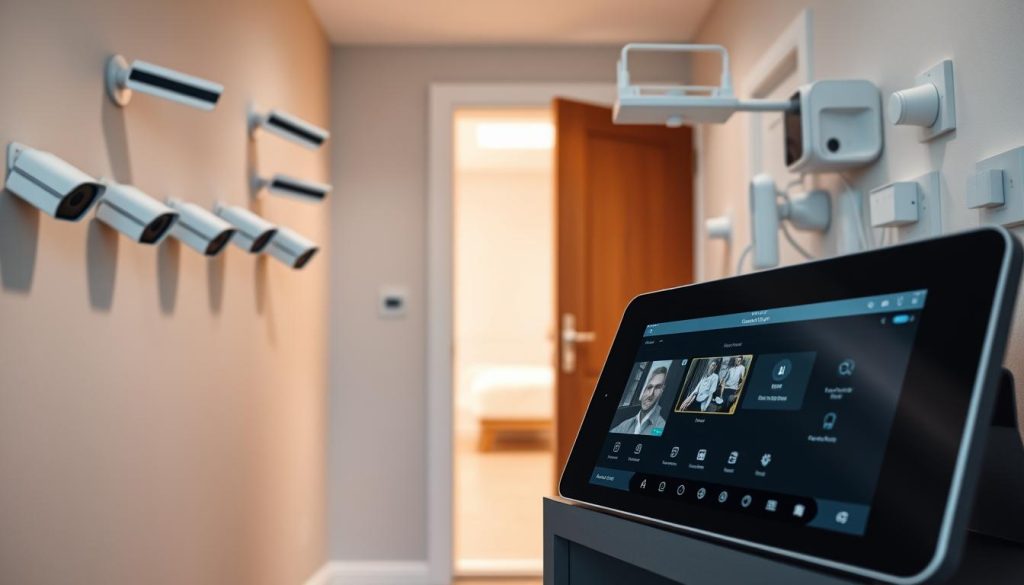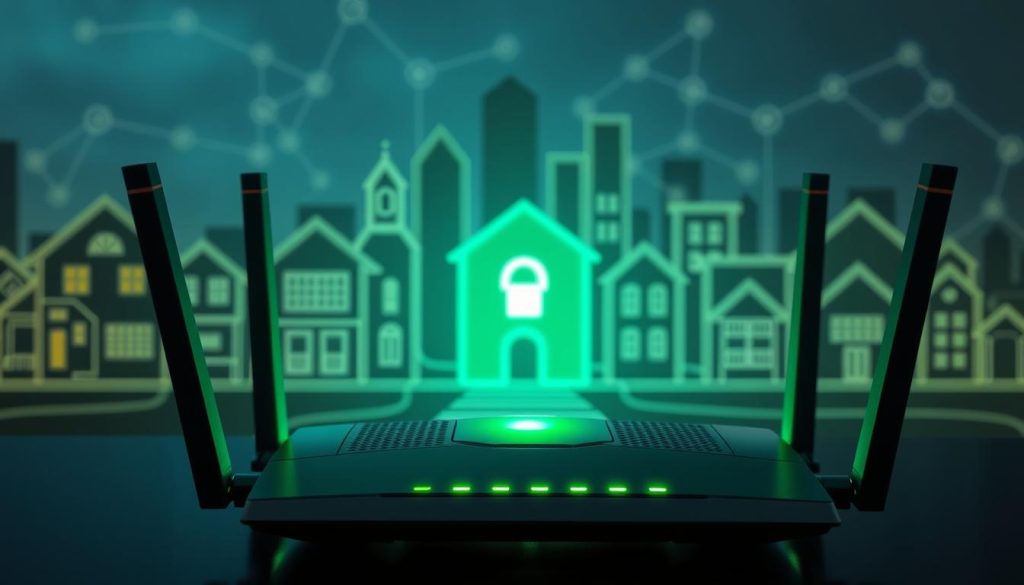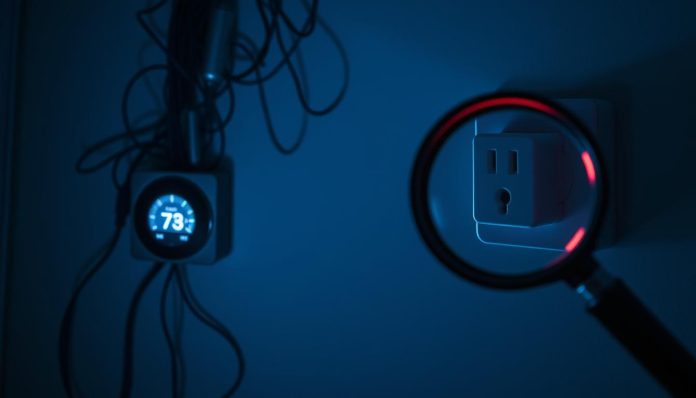The rise of IoT devices has changed our lives, making them more connected and efficient. But, this increased use of devices like smart thermostats and smart plugs also raises concerns about connected home security.
As you add these devices to your daily life, it’s key to think about the risks. Hackers often go after weak devices, which can harm your home’s security and risk your personal data.
By understanding the importance of IoT security and taking steps ahead, you can keep your smart home devices safe. This way, you can keep your connected home secure and efficient.
Key Takeaways
- Understand the risks associated with IoT devices
- Learn how hackers target smart home devices
- Discover expert tips on securing your smart thermostats and smart plugs
- Implement effective measures to protect your connected home
- Maintain a secure and efficient smart home environment
Understanding Smart Home Devices and Their Vulnerabilities
Smart home devices are getting more popular, but they also raise security concerns. As you add more devices to your home, knowing the risks is key.
What Are Smart Thermostats and Smart Plugs?
Smart thermostats and plugs make your home more convenient and save energy. They adjust the temperature based on your preferences and let you control appliances remotely. But, they often lack strong security, making them vulnerable to hackers.
IoT devices, like smart thermostats and plugs, focus on simplicity over security. They often lack encryption, which is vital for keeping data safe. Many IoT traffic is unencrypted, putting your data at risk.
How Hackers Target Smart Devices
Hackers use many methods to target smart devices, like default passwords and outdated firmware. If your device isn’t secure, it’s an easy target. Hackers can access your device and get into your home network.
Some common hacker tactics include:
- Guessing default or weak passwords
- Exploiting known vulnerabilities in outdated firmware
- Intercepting unencrypted data transmissions
Recent Incidents of Smart Device Hacks
There have been many cases of smart devices being hacked. For example, hackers have changed thermostat settings and disrupted power to appliances. These incidents show why securing your devices is crucial.
| Device Type | Vulnerability | Potential Impact |
|---|---|---|
| Smart Thermostat | Default Passwords, Outdated Firmware | Unauthorized Temperature Control, Data Breach |
| Smart Plug | Weak Passwords, Lack of Encryption | Disruption of Power Supply, Data Theft |
Why Smart Thermostats and Smart Plugs Are Attractive Targets
Home automation is growing fast, making smart thermostats and plugs tempting for hackers. With 21.5 billion IoT devices expected this year, hackers have more targets than ever.

The Rise of Home Automation
More people are using smart thermostats and plugs for convenience and energy savings. These devices are easy to control from anywhere. But, they’re also connected to the internet, making them vulnerable to cyber threats.
Smart home technology is getting more popular. Yet, many devices lack basic security, using weak encryption. This makes them easy targets for hackers.
Data Collected by Smart Devices
Smart thermostats and plugs gather personal data like temperature settings and energy use. Hackers can use this data to learn about a homeowner’s habits. They might even sell it on the dark web.
Safeguarding smart devices is key to keep this data safe. Homeowners need to protect their devices and personal info.
Accessibility and Connectivity Risks
Smart devices connect to the internet and other devices, making them easy targets. If not secured, they can let hackers into other devices. This could lead to bigger security problems.
To lower these risks, homeowners should update software, use strong passwords, and enable two-factor authentication. These steps can help keep smart devices safe from hackers.
The Importance of Securing Your Smart Home
Securing your smart home is more than just protecting devices. It’s about keeping your personal data and privacy safe. As you add more smart devices to your life, the risks grow too.
Protecting Your Privacy and Personal Data
Smart devices, like thermostats and plugs, gather sensitive info. This includes your routines, temperature likes, and location. If this data gets into the wrong hands, it could be a big privacy problem. For example, a hacker could watch who’s home by accessing your smart thermostat.
To keep your privacy and data safe, know how your devices handle data. Check the privacy policies of your device makers. Also, tweak your device settings to share less data. This can really help protect your privacy.

Avoiding Unauthorized Access
Unauthorized access to your smart devices can cause big problems. Hackers might find ways into your network. This could lead to stolen data or worse.
To stop unauthorized access, use strong passwords and two-factor authentication. Also, keep your device software up to date. These steps can help keep your home network safe.
The Impact of a Successful Cyber Attack
A cyber attack on your smart home can cause a lot of trouble. It could mean stolen data, service problems, or even money loss. For instance, a hacker might overload your electrical system with a smart plug.
| Potential Impact | Description | Consequence |
|---|---|---|
| Data Breach | Unauthorized access to personal data | Identity theft, privacy violation |
| Service Disruption | Disruption of smart device functionality | Inconvenience, potential safety risks |
| Financial Loss | Potential for financial theft or fraud | Monetary loss, financial instability |
Knowing the risks of a cyber attack helps you protect your smart home. Take steps now to keep your devices and data safe.
Basic Security Measures for Smart Devices
Protecting your smart home is key. You’ve added smart thermostats and plugs to your life. Now, it’s time to make sure they’re safe from hackers.

One basic step is to keep your devices’ software up to date. Updates often fix security holes, making it tough for hackers. Always update your devices as soon as you can.
Keeping Software Updated
Regular updates are vital. They include security patches that block hacker attacks. Enable automatic updates to stay safe.
Using Strong Passwords
Strong, unique passwords are a must. Don’t use default passwords, as hackers can guess them easily. Create complex passwords with letters, numbers, and symbols. This is a big part of IoT security.
Enabling Two-Factor Authentication
Two-factor authentication (2FA) adds extra security. Even if hackers guess your password, they need the second verification. This makes your devices much safer, making them hacker-proof devices.
Also, change your IoT devices’ default settings. Many devices have open ports and weak encryption by default, attracting hackers. By taking these steps, you greatly lower the risk of your devices being hacked.
Advanced Security Strategies for Smart Thermostats
Securing your smart thermostats is more than just basic steps. It needs a detailed plan to protect your connected home. As smart home tech grows, so does the need for strong security.
To keep your smart thermostats safe, try these advanced security tips.
Network Segmentation for Extra Safety
Network segmentation is a smart way to boost security. It keeps your IoT devices, like smart thermostats, on their own network. This way, even if hackers try to get in, they can’t reach your main devices.

Monitoring Device Activity
It’s important to watch how your smart thermostats and IoT devices act. If something seems off, it might mean a security issue. Use network tools to keep an eye on them and get alerts for anything strange.
Encryption and Secure Connections
Make sure your smart thermostats and their connections are encrypted. Choose devices with strong encryption and secure ways to talk. This keeps your data safe from hackers and others who shouldn’t see it.
Using these advanced security steps can make your smart thermostats much safer. It helps make your whole smart home more secure.
Best Practices for Smart Plug Security
To keep your smart home safe, focus on smart plug security. Smart plugs make your appliances smart but can be risky if not secured well.
Awareness of Device Features and Settings
Knowing your smart plug’s features and settings is key. Learn about its app, settings like scheduling and energy monitoring, and how to update its firmware. Also, know how to reset it if needed.
- Check the device’s manual or the manufacturer’s website for security features.
- Turn off unused features to lower risks.
- Choose strong passwords for the device and its app.
Scheduling and Access Controls
Using scheduling and access controls boosts your smart plug’s security. Set devices to turn on only when needed to limit hacker chances. Also, limit who can control the plug remotely.
- Set schedules for your smart plugs to control when devices are on or off.
- Limit who can control the plugs remotely with access controls.
- Update your access controls regularly.
Regular Security Audits
Regular security checks are crucial for your smart plugs. Check connections, update firmware, and watch for any odd activity.
- Use your router’s admin panel to see connected devices and check for unknown ones.
- Keep your smart plugs’ firmware updated.
- Watch your smart plugs’ activity through their apps or energy monitoring.
By following these tips, you can greatly improve your smart plug security. Stay aware, use scheduling and access controls, and do regular security checks. This keeps your smart home safe from cyber threats.
Recommended Security Tools and Software
Smart home technology is getting better, but so are the threats. You need strong security tools to keep your devices safe. A good security plan includes many tools and software.
Antivirus Solutions for Smart Homes
Getting antivirus for smart homes is key. It catches and stops malware attacks. Look for antivirus that protects well, with features like real-time detection and updates.
Network Monitoring Tools
Network monitoring tools are vital for smart home security. They watch your devices and alert you to threats. This way, you can keep your smart home safe.
Home Automation Security Systems
Home automation security systems are a great choice. They have features like intrusion detection and alerts. These systems make your smart home much safer.
Also, think about getting a smart home firewall or security gateway. They watch IoT traffic and add extra security. With these tools, you can make your smart home very secure.
When picking security tools, choose well-known brands with good support and updates. This keeps your security up to date against new threats. Stay informed and proactive to enjoy smart home tech safely and hacker-proof.
Comparing Popular Smart Thermostats and Plugs
Choosing the right smart thermostat and plug is key to securing your smart home. It’s important to compare their security features, user reviews, and prices. This helps you make a smart choice.
Features That Enhance Security
Many smart thermostats and plugs have advanced security features. Some offer end-to-end encryption and two-factor authentication. These features greatly reduce the risk of unauthorized access.
Brands that focus on security by publishing whitepapers and working with security firms are more reliable.
When checking these devices, look for:
- Regular software updates to fix vulnerabilities
- Secure communication protocols like HTTPS or TLS
- Ability to segment your network for extra security
User Reviews on Security Performance
User reviews offer insights into a device’s real-world security. Look for mentions of secure connections, easy-to-use security features, and any security breaches.
Some users have praised brands for their seamless integration with existing security systems and prompt customer support. Reading reviews on different platforms gives a complete view of a product’s security.
Price and Value Considerations
Security is crucial, but price and value are also important. More expensive devices might have extra security features or better performance. But, it’s key to decide if these extras are worth the cost.
Some brands offer great security at a fair price. For example, certain models might have strong security without breaking the bank. When comparing, think about the total cost, including any subscription fees for security services or software updates.
Future Trends in Smart Device Security
Smart device security is set to change a lot in the future. New tech will help keep your home and data safe. It’s important to know about these changes to stay ahead in smart home security.
Innovations in Smart Home Security
New tech is making smart home security better. This includes better threat detection and stronger encryption. These updates aim to keep your devices safe from cyber threats.
Key Innovations:
- Advanced threat detection systems
- Enhanced encryption protocols
- Improved device authentication mechanisms
The Role of AI in Future Device Protection
AI is becoming a big part of IoT devices. It helps find and stop threats automatically. AI systems can spot unusual behavior and act fast to protect your devices.
| AI-Powered Security Features | Benefits |
|---|---|
| Real-time threat detection | Immediate response to potential threats |
| Behavioral analysis | Identification of unusual device behavior |
| Automated threat mitigation | Reduced risk of device compromise |
Regulatory Changes Affecting Smart Device Safety
Government and regulatory bodies are focusing on smart device security. New rules are coming to make sure devices are built with safety in mind.
Key Regulatory Changes:
- Mandatory security standards for smart devices
- Increased transparency regarding device security features
- Stricter data protection regulations
These changes will help make sure your devices are secure from the start.
Conclusion: Taking Action to Protect Your Smart Home
Smart home technology brings many benefits but also risks. To keep your smart home safe, you need to act on IoT security and device protection. By knowing the dangers and taking steps to avoid them, you can enjoy smart devices safely.
Key Takeaways for Smart Home Security
To protect your smart home, start with basic steps. Keep software up to date, use strong passwords, and turn on two-factor authentication. Also, know how to use your devices’ features to block unauthorized access.
Staying Safe in a Connected World
Smart homes are not inherently dangerous. But, their safety depends on your actions. Stay informed about threats and pick secure devices. Your smart home’s safety is up to you. Taking action now will make your connected home safer.

